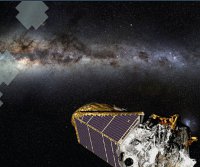Projects
K2 mission

K2 inherits the on-orbit Kepler spacecraft with its 0.95-meter aperture and 100 square degree field of view, the Kepler ground systems to operate the spacecraft, and the Kepler infrastructure to process and archive the data collected. Aside from the failed reaction wheels, the spacecraft has shown little performance degradation and the remaining reaction wheels show no signs of wear. The only fundamental change to the operation of the spacecraft is attitude, pointing in its orbital plane (approximately the ecliptic) in order to minimize the impact of solar radiation pressure, and the concomitant changes to attitude control and communications strategies.
The K2 mission is driven by its ability to maintain spacecraft pointing in all three axes with only two reaction wheels. Solar pressure represents a disturbing force, which is controlled by reaction wheels about the Y & Z axes, but controlled only by thrusters about the X-axis. Sustained, stable pointing requires that the X-axis disturbing force be minimized for extended periods. This is accomplished by pointing in the orbital plane, where the apparent motion of the sun (caused by the spacecraft’s orbital motion while inertially pointed) follows the spacecraft X-Y line of symmetry, providing a balanced pressure and little X-axis disturbance. By selecting carefully the initial spacecraft roll angle and correcting for drift every 12 hours with thrusters, the spacecraft can remain stable in roll for up to 85 days with a fuel budget that allows for a 2-3 year mission duration. Meanwhile, the reaction wheels control pointing about the Y and Z axes as in the Kepler mission, absorbing the torque generated by the solar radiation pressure and dumping momentum through thruster firings every 48 hours.